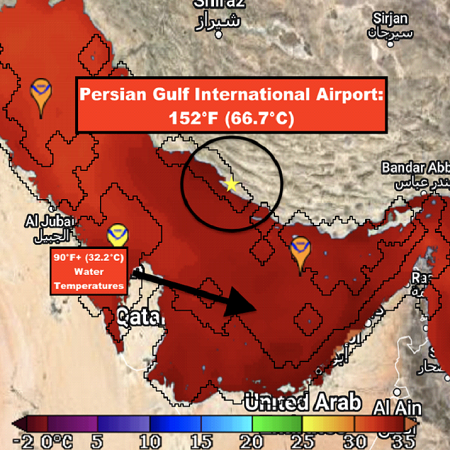

8th September 2023 (9 Topics)
Context:
As per a recent report, Iran’s coastal region has recorded a scorching heat index of 70 degrees Celsius (°C) in the coastal part of the country, a metric at which survival of life is not impossible. Also, the region recorded a heat index of 66.7 °C.
What is a Heat Index?
- Heat index, also known as apparent temperature, is a measure of how the temperature feels to humans.
- Relative humidity is an important factor that determines heat index, along with air temperature.
In 2024, India is scheduled to launch its own heat index to quantify the impact of heat on its population and generate impact-based heatwave alerts for
This formula considers factors like temperature, humidity, wind speed, and barometric pressure to determine the apparent temperaturespecific locations. |
How Heat index is measured?
- or what humans perceive as the temperature.
- Considerations for a "Typical Adult": Dr. Steadman's study was based on a "typical adult human of either sex, with a height of 1.7 metres and a weight of 67 kg."
- This standardization allows for a consistent calculation of heat index applicable to a broad range of individuals.
- Inclusion of Dew Point: Dew point is a critical factor in heat index calculations.
- It represents the temperature at which air can no longer hold all its moisture, causing condensation.
- Dr. Steadman used a specific dew point value of 14°C in his calculations.
- This factor is crucial in assessing the sultriness or discomfort associated with a particular temperature-humidity combination.
- Alternative Indices: While Dr. Steadman's formula is widely recognized, some countries, like Canada, have developed their own indices.
- Canada uses Humidex, which considers temperature and dew point, but has its own specific formula for calculation.
- This emphasizes the importance of tailoring heat index calculations to local climate conditions.
Why a specific heat index is important?
- Moisture Capacity and Apparent Temperature: Hot air has a greater capacity to hold moisture than cold air. When the temperature rises, the air's ability to hold moisture also increases.
- This affects the apparent temperature or heat index, making humid air feel even hotter to humans.
- This is why the heat index is a more useful metric than just the temperature alone.
- Effects of High Humidity on the Body: High humidity during heatwaves can lead to heat stress.
- In these conditions, the body struggles to dissipate excess heat.
- Impact of Humidity: Conversely, in low humidity conditions, sweat can evaporate more efficiently, making the apparent temperature feel closer to the actual air temperature.
- Dangerous Heat Index Values: A heat index value of 67°C or above is extremely dangerous for both humans and animals with direct and prolonged exposure. At this level, heat-related illnesses become a serious risk.
|
About the Location:
|


